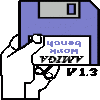I would like to introduce an abstract Concept into the A.I. and Gaming community.
My only qualification is perception.I precieved the idea of a new concept there fore am qualified.
This being said;,I, really need a professional to understand,interpite,develope,and verify it's
potentual.
My belief is that it will introduce logic,and relitivity to programming;,Not,As a fast action,but,as an efficient over all learning process.
Just as A.I. learns with repatition this could be used to relate logics,and relations over time.
My introduction to the abstract concept begins with the observations which lead me to it.
This is important to show the facts from the abstract usses.
1. Parrallel resistance
A. effectiveParll_restance= 1 / ((1/r1)+(1/r2)+(1/r3)---)
a1. effectiveParll_restance is always less than least resistor.
a2. Before the last {1/} the sum is always intuativly a unique extension to the vector length. ie. .5+.25+.25 +.125=1.125
a3 The {{ effective_resistance is relitive to the lost_resistance and the total_resistance ie; effective_resistance = Total +(lost*-1) }} ie; 0.625= 1.125+((.25+.25)*-1) == .5 +.125
a4. Abstract:
if resistance is an asc(code) ie:asc(*) is 49, then the total of "country United States" is relitive to " United " = { "country United States" + (("country +States" )*-1)
B. Parrallel resistance program_loop format.
b1.
Stream$="800 96 50 12"
total=val(Stream$,x)
loop
x=x+1
r=val(Stream$,x)
total=(1/ (r*(1/total)+1)))*r
next loop
note total=8.69565217 == 1/((1/800)+(1/96)+(1/50)+(1/12))
ABSTRACT:
b1a. Observe the percentage relation r*%= effective_total
b1b .Observe A= atn(%)
A1
A2
A3
final A =A3 Note that r(n)= total(n)*(1/tan(A(n))) or T(n)=R(n)*(1/tan(A(n))
final total=final total
This is where logic_relative_addressing and relative_logic comes into play.
Abstract::
A Abstract relitive logic
1. P>0 .5
2. P<0 * .25
3. H=0 .136
4. H>0 * .33P<0
5. P=1 .4
total = 1.616
6. Abstract relitive logic mixer : ( {1.616 - 1.036 = .58} *-1) + relitive total ==
13 == " P<0 , H>0 " == "quadrent 2"
B Abstract relitive addressing
1 Page unique_code = 0.02425
2 Options unique_code total = 0.325
3 address is 0.30075= 0.325+(0.02425*-1)
4 action== goto "[";"0.30075";"]" == goto [0.30075]
'***************************
[0.30075]
open "page25.txt"
return
C Note the action is based on relations of content not on the content. ie; the action is assigned thru the relations that define it.
Heavy concept?? yes!
No one said dealing with logic,relitivity,reasoning,and selfawarness was simple.BUT YOU NEED TO START SOME WHERE. To understand it.
I believe this to be the starting place.
I need help proving it.
This is only an incomplete glimps at the detail.
'********************************************************************
SHOWING WHERE T AND A ENTER THE EQUATION::
Pr=1e100
{T(1),A(1)} {T(2),A(2)} {T(3),A(3)} {T(4),A(4)} Not in Formula form
Pr=(1/1e100) (1/800) + (1/96) + (1/50) + (1/12)
'********************************************************************
Pr=1e100 'initialize 'Abstract T
T=Pr
A=45 'initialize { relativity }
{ Pr) {T}
%= 1 / ((800*(1/1e100)) +1)
Angle=atn(%) 'Abstract A(0) -- Angle
T=800*tan(A) 'Abstract T(0) Pr(1)=T -- total(0)
T(1)=800
A(1)= 1 / ((800*(1/1e100)) +1)
Angle=atn(%) 'Abstract A(0) -- Angle
T(0)=800 'Abstract T(0) == Pr(0)=T -- total (0)
A(0)=45
{{ 'initialize complete}}'
'@@@@@@@@@@@@@@@@@@@
[loop]{1}
{ Pr} {T}
'''''/%= 1 / ((800*(1/800)) +1)
''''/ Angle=atn(%) 'Abstract A(0) -- Angle
T=800*tan(A) 'Abstract T(0) Pr(0)=T -- total T in Program form
T(1)=800
%(1)= 1 / ((800*(1/800)) +1)
Angle=atn(%) 'Abstract A(1) -- Angle A in Program form
T(1)=400
A(1)=26.565051177077989351572193720453
next [loop]
'@@@@@@@@@@@@@@@@@@@
[loop]{2}
{ Pr} {T}
''''/%= 1 / ((96*(1/800)) +1)
''''/Angle=atn(%) 'Abstract A(2) -- Angle
T=96*tan(A) 'Abstract T(2) Pr(2)=T -- total
T(2)=85.714285714285714285714285714286
%(1)= 1 / ((96*(1/800)) +1)
Angle=atn(%) 'Abstract A(2) -- Angle
T(2)=400
A(2)=41.760299703897870309452138780517
next [loop]
'***********************************************************************************************
With T and A in the equation it is concievable to back_track the process. ie; T=Pr*tan(A) and Pr=T*(1/tan(A))
'@@@@@@@@@@@@@@@@@@@@@@@@@@@@@@@@@@@@@@@@@@@@
Now the hard part..
This is the relitivity system.The SYSTEM that makes the Final_Code {FCode} relavent.
Pi=atn(1)*4:Mdeg=(180/Pi):Mrdn=(Pi/180)
DL$="800 96 50 12 3 7 18 21 41 45 96 50 12 3 7 18 800 96 50 12 3 7 18 21 41 21 41 45 96 50 12 3 7"
Pr=val(word$(DL$,1)):F=Pr
Pr=1e-100
for j=1 to Lng(DL$)
R=val(word$(DL$,j))
FCode=FCode+((1/R)+(1/A))
gosub
gosub [Decode]
next j
print eDL$
print FCode
end
'print R
c=abs(1/(R*(Pi^2)))
c1=c
Pr=F
A=atn((1/((R*(1/F))+1)))*Mdeg
L=(A*(1/(Pi^2)))
F1=1/(((L*c)^.5)*(2*Pi))
Pr=R*tan(A*Mrdn)
'print Pr
return
[Decode]
print R
c=abs(1/(R*(Pi^2)))
c2=c
F2=1/(((L*c)^.5)*(2*Pi))
'L2=((1/F2)/(2*Pi))/c2
F=(1/((1/tan(A*Mrdn))-1))*R
A2=L*(Pi^2)
D=Pr*(1/tan(A*Mrdn)):eDL$=eDL$;str$(int(D));" "
'print tab(16);D;" ";F1+(F*-1);" ";A2+(A*-1)
return
'@@@@@@@@@@@@@@@@@@@@@@@@@@@@@@@@@@@@@@@@@@@@
The relivence of the FCode is the logic of the system.
Rule is {relitive to the system} FCode of "one apple = 35 cars" = only "one apple = 35 cars"
Therefore box_Fcode is the same as box_"one apple = 35 cars" ;, But , box_Fcode + box_Fcode2 is _"one apple = 35 cars" + box_something else. ie; "P<0" + "H<0"= "Quadrent 2"
How???? assigned logic --- if Code(1) + Code(2)= 0.73433 then GOTO= { Code= (Code(1) + Code(2) +Code(3) ) + ((Code(1) + Code(2))*-1) }
if GOTO= ? then print "Quadrent 2"
Now where we used resistance before;,We, can use coded logics and relate them as effective_Logic= 1/ ( (1/EL1) + (1/EL2) + (1/EL3) --)) or Gain=(Total+(Loss*-1))
The difference is that these are assigned abstract relitive relations {relitive to the rule of the abstract System}
Now we can assign logics,relations,relitivity,reasoning,creativity, ect -- as temporary or constants.
At {LEAST} it is a start at understanding how it works.
If interested My e-mail is [deleted by moderator]










